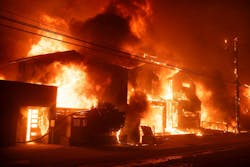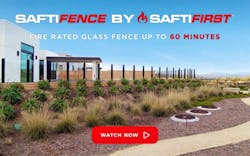Considerations to Make when Rebuilding After the Devastation Caused by the California Wildfires
SAFTI FIRST has been a proponent for safer building construction in high fire risk areas for over thirty years. It began with code change proposals, followed by more code change proposals, with no change over many years. With each code cycle, there is a constant battle between manufacturers promoting new fire safety materials versus other manufacturers with current market share arguing for the status quo.
It was heartbreaking to witness the devastation inflicted on the communities in the recent Southern California wildfires. As a lifelong Californian with a career dedicated to developing building products that safeguard people and property from destructive and life-threatening fires of this type, it is our hope that the focus will shift to more safe and secure rebuilding of these homes and with proven and tested fire-safe materials. Thereby providing a safer community and more insurable structures.
Architects, contractors, and other professionals involved in providing fire-resistant construction will necessarily need to research for new fire-resistant, safer materials for their designs. This will include the consideration of not only fire protection for their site but also the safe separation and materials to eliminate fire spread to adjacent sites. For architects and general contractors, the understanding and implementing of these safer options of materials and construction will safeguard and protect the entire community.
Some Obvious Recommendations
- Roofing – By using either metal roofing, clay, ceramic tiles or treated and fire rated wood shingles.
- Exterior walls – Using non-combustible materials like brick, stone, stucco, fire rated treated wood siding, insulated metal panels, or other fire tested and rated materials.
- Sprinklers – Installed throughout the structure, including the basement, deck (if flammable) and attic. Consideration of having the design include a secondary source such as a pond, swimming pool or underground storage tank. With an automatic change over valve if your normal source pressure is disabled.
- Eves – Install fire rated, self-closing eve vents with fire-resistant and ember-resistant air filters.
- Doors - Use listed and tested fire rated doors and fire rated openings. And for exterior areas or for large expanses of glazing like openings to patios, use 60-minute fire rated assemblies.
- Windows – Present the greatest threat to the house as they are the proven most likely source of fire entry and fire spread. It is well documented that glass in windows breaks and falls when subjected to temperatures above 300 degrees Fahrenheit, which is well below the temperatures reached in a wildfire, where they can reach 1800 degrees Fahrenheit. When even the lower temperature is reached early in a wildfire, glazing becomes an invitation for the fire to enter into a home, igniting interior fuel sources such as drapes, furniture and carpets. With this immediate access to fuel, it quickly leads to the entire structure being engulfed in flame.
The Vulnerability Of Annealed Glass or Traditional Non-Rated Tempered Glass
Annealed glass that is provided for most homes becomes the weakest point of a home’s construction in a wildfire. It shatters in as little as three minutes of exposure. Traditional non-rated tempered glass also breaks and falls out but at a higher temperature. Therefore, it is also unsafe. Only a tested and fire rated product should be used to provide greater protection.
The Advantages of Fire Rated Glass
Unlike annealed and traditional tempered glass, fire rated glass is tested, rated and designed to withstand these higher temperatures and the physical stress when subjected to a wildfire. This glazing material is used in areas where fire protection is needed up to 45-minutes.
Devastating wildfires have become an increasingly concerning threat. With more areas being designated as Wildland Urban Interface (WUI) zones, it is therefore all the more important to educate, evaluate and research the many new and safer products for construction to be able to meet these new and stricter requirements.
Specialty Tempered Heat Reflective Glass and Fire Rated Glass used in Windows, Doors and Fences
SuperLite I-XL, developed and patented by SAFTI FIRST in 1980, is the first such glazing sold in the US. SuperLite I-XL is used for fencing for fire prone areas, and often seen along the California coast, used for fire safety and property separation. SuperLite I-XL is a fire protective heat reflective glass that is tempered with a proprietary patented formula with a prescribed edge treatment. This patented process allows it to be used for fire protective areas.
SAFTI FIRST has developed a comprehensive line of fire rated glazing and framing, with new products designed for special conditions, like hurricane and tornado, recently released. And with our new laminating line, we are also providing ballistic and bomb blast glazing.
SAFTI FIRST wishes all those that have been impacted by these violent wildfire events our blessings and our well wishes in your recovery and rebuilding.
Architects, contractors, homeowners or other professionals wishing further information on our glazing, framing, door or floor products, please visit our website SAFTI.COM or TITANMETALPRODUCTS.COM for information on our specialty door products. Our project managers, area representatives and in-house sales professionals are always available for consultation. Thanks for following SAFTI FIRST.
About the Author

William O'Keeffe
About the Author: William O’Keeffe is the President and CEO of SAFTI FIRST Fire Rated Glazing Solutions, a leading USA-manufacturer of advanced fire rated glass and framing systems. An industry veteran and innovator with over 45 years of experience in architectural glazing, he was first to introduce and manufacture clear, fire resistive glazing products in the US. He is also a safety advocate who exposed the dangers of traditional wired glass, which lead to code changes and fire rated glass products that are safe, affordable and clear alternatives to traditional wired glass. Today, William continues to develop building products that enable architects to create beautiful, safe and energy-efficient spaces with advanced glazing systems.

